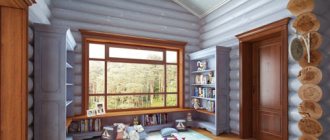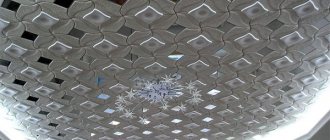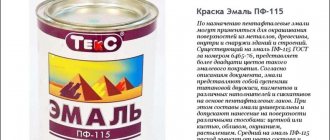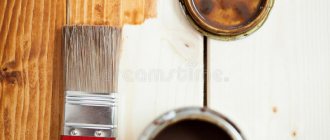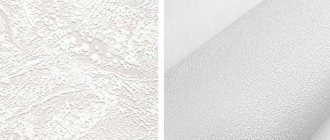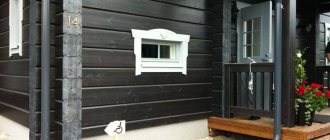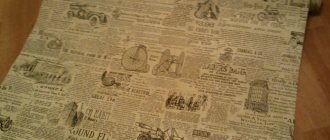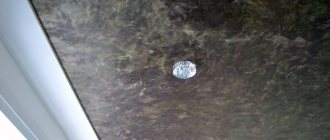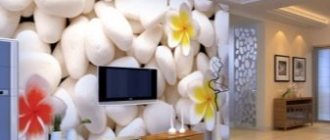When painting living rooms, utility rooms or facades, you must use paint materials from the same batch. In order not to waste time later searching for the right shade, you need to buy paint with a reserve. Independently calculating the consumption of acrylic paint per 1 m2 of wall or ceiling is a feasible task that any novice painter can handle.
Acrylic paints are safe for humans and animals.
Advantages of choosing a base for painting
A base for painting is the best option for wall cladding for those who are changing the interior. The main difference between the material for painting is its repeated staining.
When there are kids in the house and renovations are underway, wallpaper for painting simply suggests itself. Although their cost is higher, children’s drawings will be easy to remove from the walls.
On the market there is a choice of materials based on texture: patterned, smooth, convex. It is classified among itself according to the base material and the volume of the surface to be painted:
- with fiberglass base;
- on non-woven fabric;
- vinyl;
- impregnated thick paper;
- relief in volume - linkrusta.
Roll material on sale is white, translucent. Also available in color. When painting wallpaper for painting, it is recommended to start with a light tone. Each subsequent paintwork will be one tone darker.
Disadvantages of Wallpaper
The disadvantages include:
- the next time, some types of wallpaper will be difficult to remove from the wall, since they have very strong adhesion to the wall, thanks to high-quality glue;
- If the wallpaper does not have a special top layer, it is difficult to remove dirt. When interacting with water, the wallpaper may deteriorate. Recently, it is not uncommon to find special washable wallpaper;
- the coating is easily damaged by pets. Although this will not harm your pet, such wall decoration will lose its presentation and the effect of the renovation will quickly disappear;
- They are not recommended for gluing in rooms with high humidity. Wallpaper will quickly deteriorate and peel off;
- Wallpaper, even with perfect gluing and operation, will have to be replaced after 5-7 years. They are not designed to last;
- Even with slight interaction with a sharp object, the coating will tear.
Calculation of the required quantity of coatings
To avoid having to interrupt work or even repaint everything, the required amount of paint and varnish is calculated in advance. Its consumption depends on:
- on the area of the entire surface that will be painted;
- from the manufacturer’s indicator - material consumption per 1 m2;
- on the ability of the base to absorb paint.
To calculate the area to be painted, the area of all walls is added together. A ceiling is added to them if paint and varnish is applied to it. The length of the wall multiplied by its width is the surface area that will be covered with dye. But for the accuracy of calculations, before painting the wallpaper, the parameters of windows and doors are subtracted, and a reserve is added in case the paint is strongly absorbed.
It is recommended to purchase the dye from one manufacturer. Since paintwork materials of the same type differ from different companies in consistency and degree of absorption. Therefore, their consumption will be different. The manufacturer indicates the paint consumption rate on the can or in the instructions. It is considered a standard figure if the consumption is no more than 180g/m2, the dye is applied in 1 layer; 250g/m2, applied in 2 layers. Each paint base absorbs dye differently. For paper and non-woven materials, this degree is greater than for vinyl or fiberglass.
The dye density according to the wallpaper standard weighs 1.50 kg. This figure is 1.5 times higher than that of 1 liter of water. Therefore, it is not recommended to immediately apply paintwork after gluing.
We recommend videos on the topic:
LMB selection
Paints are selected based on 2 important factors:
- what base will be painted;
- function of a room where the walls and ceiling are covered with a base for painting.
The type of dye is selected for the base:
- from thick paper - water-based CM is applied;
- for non-woven fabric, water-dispersed CM is purchased;
- fiberglass material - painted with acrylic or lactex dye;
- linkrust - wax paste and liquid acrylic oil coloring material are applied.
How to calculate area
To calculate the total amount of material needed for repairs, you need to calculate the area of the surface to be painted. To find the desired value, it is worth remembering the school mathematics course. When painting a ceiling, it is enough to measure its length and width and multiply the resulting values (in meters).
To determine the total area of the walls you will have to make more complex calculations:
An example of calculating the area of a wall with a doorway.
- For rooms, multiply the perimeter of the floor by the height of the walls; for facades, multiply the perimeter of the house by its height.
- Find the area of all windows and doorways.
- If you need to additionally paint niches, ledges, columns or half-columns, calculate the size of their surfaces.
- Determine the total area for painting - subtract the second from the first result and add the square footage of additional architectural elements to the resulting value.
After all the calculations, you can begin to determine the consumption of acrylic paint.
Advice from the experts
- In rooms with a lot of moisture and frequent washing of walls (in the bathroom and kitchen), acrylic or latex is recommended. Although the walls do not breathe well, the film that forms after their application protects them from moisture and cleaning agents.
- Since latex paint is resistant to direct sunlight, it is recommended in sunny rooms.
- When choosing a coloring material, light reflectance is important. They are distinguished by masters: matte KM, semi-matte, satin and glossy dye.
Characterized by its durability, satin paint is most often used in the kitchen, bathroom, and toilet.
For a sunny room or where defects in the surface of the walls and ceiling are clearly visible, matte paint is recommended.
Gloss will add light to a dark room. A sponge with a glossy dye is used to paint the relief with a matte background.
- Acrylic is considered a universal material with a long shelf life. The water-based material is easy to use.
- Any type of paint should not be applied to a wet base. After covering the walls with wallpaper, you need to wait 3 days.
- Before repainting the wallpaper the next time or when applying the dye for the first time, it is recommended to first apply the dye to a sample of the wallpaper to see the intensity of the shade. You may need to add pigment.
- Painting is carried out in the following sequence: ceiling, walls free from furniture, walls covered with furniture.
- Since CM tends to dry out, the jar with it is not opened in advance.
- Before applying the water-based material, pigment is added to it. This is how it gets shaded. It is important to remember that when dry it will be a lighter tone.
Consumption of acrylic paint for facade work
Painting the external walls of the building should be carried out at an ambient temperature of +5...+35°C. For finishing work, it is advisable to choose dry, windless weather. To save paint, you need to prime the surface of the facade and wait until the composition dries completely.
Thanks to this preparation, the consumption of aqueous dispersion will not exceed 180-200 g per 1 square meter. m. If you apply paint directly on plaster, brick or cinder block, the amount of material consumed can increase to 220-250 g per 1 sq. m. m.
Preparing tools
A simple and easy-to-use tool is a roller. Even a novice painter can handle it. There are tools with different lengths of pile, with different attachments (foam rubber, fur). They achieve different effects. So, for example, with a short pile, a relief pattern is painted. If you lightly touch the surface of wallpaper without a relief with a foam nozzle, uncolored bubbles will form.
Places where it is difficult to go through with a roller are painted with a brush.
The paint is prepared in a separate container. Later it is poured in parts into the cuvette.
Design selection
You can combine colors in several ways:
- match shades that are similar in tone (for example, neutral colors like beige and pink, gray and blue);
- implement gradient coloring (using smooth transitions between identical shades of different levels);
- use a different palette (most often bright and light colors are combined).
In order to hide the boundaries between different colors, use moldings, borders, strips, slats, and wallpaper tape. Calculate the required amount of paint in advance - and take a little in reserve. This will allow you to correct some errors on the walls, and will also save you from having to search for a similar shade if you incorrectly calculate the required amount of paint.
Important! When choosing paint colors, focus on the size of the room: light shades will emphasize the free space, while dark and bright shades will reduce its area.
Comparative characteristics
So, what is better: wallpapering or painting the walls? Let's approach this issue from all sides, comparing possible costs, visual perception, environmental friendliness, practicality and operation.
Expenses
What is cheaper: painting the walls or hanging wallpaper? If we take into account that hired workers will not be used, then everything depends on the cost of the materials themselves. Their prices are very flexible.
There are expensive and cheap samples in both cases, and the balance between cost and quality is always fairly well maintained.
Their prices are very flexible. There are expensive and cheap samples in both cases, and the balance between cost and quality is always fairly well maintained.
So, for complete finishing of the same area, approximately the same budget will be required. There is no clear leader in this category.
Environmental friendliness
The fact is that the paint is either toxic due to the solvent content in its composition, or absolutely harmless if ordinary water is used as a base. And it is these water-emulsion suspensions that have become widespread today. It is noteworthy that this even had a downward effect on the price, since H2O is much cheaper to use in production.
With wallpaper the situation is different. Environmentally friendly models are quite expensive, but cheap ones are not poisonous, although you will need to think about using them in a nursery.
In terms of environmental friendliness, emulsions still take the lead in our imaginary competition by a small margin.
Practicality
Acrylic paint can be washed, and it withstands mechanical damage, ultraviolet exposure, temperature changes quite well and does not burn. It can even be used for facade work. Durability reaches ten years.
Most types of wallpaper are very capricious. And even washable non-woven or vinyl samples still will not withstand, for example, use in outdoor conditions. Although they cope with the protection of walls no worse than suspensions.
Positive and negative sides of wall decoration with wallpaper
To make a choice, you must first decide who will do the finishing work. If your finances allow you to hire a specialist to carry out repair transformations, then many factors that could be attributed to the disadvantages of a particular method will no longer be such. But in the case when the work will be carried out on your own, it is worth taking into account all aspects related to the finishing process and the timing of certain works, the choice of material and its quality. It is likely that, having finally chosen between the option of hanging wallpaper on the wall and the option of painting it, some work will still have to be entrusted to a professional so as not to sacrifice quality.
Depending on the choice of a specific type of facing material, wallpapering walls can have the following advantages:
- ease of installation, allowing even a person without experience to perform high-quality finishing;
- the simplicity of the procedure for preparing walls and the comparative cheapness of the consumables required for this;
- the ability of many types of wallpaper to hide minor defects of the surface being pasted;
- soundproofing properties of such a coating.
The disadvantages of wall decoration using wallpaper include:
- the fragility of this facing material, forcing it to be replaced with a new one after a few years;
- the significant labor intensity of the wallpaper installation process itself, if you do not take into account the labor costs for preparing the walls;
- the unsuitability of this material for finishing new walls, due to the fact that after the final shrinkage of the building, cracks may appear in them that can ruin the facing coating;
- the impossibility of eliminating mechanical damage if there is no suitable spare material;
- limited range of aesthetic design options presented by the manufacturer.
What to Expect When Painting Walls
Perhaps by painting the surface, you can solve many problems that arise specifically in your situation. Painting walls is not difficult; caring for painted walls is easy. But this also has its downsides.
| Advantages | Flaws |
| Provided that the preparation of the surface for painting is done professionally (and this is what the craftsmen of our private team “Remontami 7” can offer), the walls will significantly “improve” the room and then no finishing will be required for many years. | A non-specialist will only make things worse when performing the work, and the preparation process itself is labor-intensive. Good work simply cannot come cheap. |
| The ability to tint problem areas in fragments, and this fact saves money. | Subsequent touch-ups are available to a beginner, but to initially completely paint a room flawlessly is only possible for a professional who will not charge a penny for his services. |
| Painted walls are very easy to clean, all stains can be washed off in one go! | Painted walls even need to be washed, because... they strongly attract dust. However, this does not apply to glossy paint. |
| Painted walls are of no interest to pets, even the most playful ones. | There is paint that is resistant to mechanical damage, but nothing lasts forever and chips from strong impacts are possible. |
| The possibilities for tinting paints have no limits. With such a variety of color saturation and texture, it is possible to create any interior. | The cost of working with textured paints or stencils is not cheap, and the choice of material itself will cost a pretty penny. |
As can be seen from the table, it is impossible to say unequivocally what is better: painting the walls or hanging wallpaper.
Everything will be decided by the specific situation, the interior required as a result of the renovation, the original condition of the walls and much more. But often the choice of finishing option will depend on the answer to several main questions:
- Will you do the finishing of the walls yourself or will you hire a professional? With regard to wallpapering, we can say that such work can be done yourself; we will not discuss the issue of perfection. Painting requires plastering work, which a non-professional cannot do.
- Is your budget for wall decoration limited? Wallpapering does not require investing significant sums in finishing. Painting will require more expenses. But if the initial condition of the walls is ideal and no preparatory work is required, the main costs will go to paint. It is possible that in this case, painting the walls will cost even less than hanging wallpaper.
- For how long do we do the finishing? For those who like to frequently change the environment, wallpapering is more suitable; after about 5-7 years it will be possible to update the surrounding interior. For those who want to make repairs and forget about any large-scale changes, painting is more suitable. In this case, you can update the walls and eliminate defects in fragments, and repainting the entire surface in a new color will not be difficult.
- Is the shade of the walls very important to you? Everything is simple here: in the case of wallpapering, we glue what the manufacturer produced. When painting, we have the opportunity to carefully choose the shade and even texture.
| Preparing drywall for painting | How much should wallpapering cost? | Why do you need a primer? | Options for decorating hallway walls |
